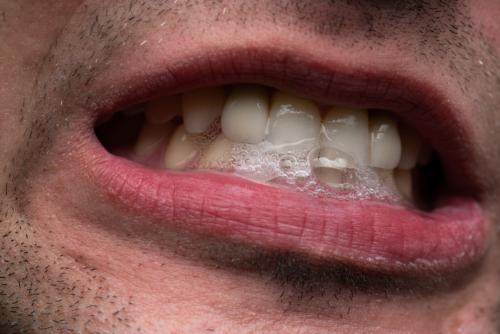Dental pulp and necrosis pulp

Any environmental factor acting with increased intensity on the tooth or coming into direct contact with the dental pulp may be causative agent. Specifically, these causal agents are represented by excitations to, traumatic mechanical agents, chemical agents and microbes. Extremes of heat and cold, whether they are brutal (vitality tests pulverize with carbon snow or dents of cavities or cavities without the protection of dental pulp), whether they are of small and repeated intensity (metal fillings, passing the same meal from the diet . The pulp can also be affected by brutal mechanical trauma agents (tooth fracture) or low intensity but repeated (professional habits: tearing of yarns with teeth, keeping nails between teeth, unadapted prosthetic works, uncontrolled orthodontic maneuvers). And chemical agents can produce pulpits. Frequently, these aggressive agents come from dental materials.
Drugs based on phenol and formol, concentrate, perhydrol, composites are incriminated. Pulp inflammation appears most often under the action of aerobic or anaerobic microbial agents that act indirectly (through microbial exotoxins) or directly (through the penetration of the microbial agent into the dental pulp) In pre-inflammatory hyperemia, which draws the attention of the patient is the pain caused by the excitations . The pain is localized, the patient accurately indicating the tooth in question. It has a moderate intensity and it only takes a few minutes after the exciting removal. In the acute coronary artery pulp, the patient accuses a living pain, localized to a tooth, caused by the beginning and later by the warmth.
Pain is manifested for a longer duration than in pre-inflammatory hyperemia, it may take from a few minutes to a few hours. Painful crises can also occur spontaneously, especially in the evening or at night, and can crash on their own, but it is usually necessary to administer painkillers. In the acute serotype acute pulp, the clinical picture is dominated by the acuity of the painful phenomena. Pain lasts for a long time (hours) and is very intense. French authors call it \.
The pain is no longer localized, irradiating to the submandibular, temporal or orbital region. This irradiation never exceeds the median line of the face. The usual painkillers do not attenuate the pain. In purulent wounds, the pain appears hot, so the patient is used to holding a cold compress on the face. The character of the pain is pulsating and very powerful.
Initially, the pain is localized, then radiated in the hemifacts. The purpose of treating injured and inflamed pulp is not only the suppression of clinical signs but, above all, the preservation of pulp vitality, even if it is not a \. The usual treatment methods are: 1. Biological methods of total preservation of the dental pulp) indirect stamping (after the removal of the affected dental tissues, the dentinal wound surface is applied to the calcium hydroxide paste to trigger the new dentine formation); b) the direct stomach (after the removal of the affected dental tissues . 2.
Methods to completely remove the dental pulp) Vital extirpation (Remove the damaged dental tissue, then the affected dental pulp, then proceed to use the canal paste and guttaperc's cones) b) Extrude the devitale (proceed as if you were extirpating . By pulp necrosis is meant aseptic mortification of the pulp, with the exhaustion of its defensive means, under the aggressive action of some physicochemical factors. Causal factors are traumatisms, very high or low temperatures on the surface of the teeth, or chemical-toxic factors (formol, trioximetilen, silver nitrate) Symptomatology is very poor. Often the tooth is indolent, but there is less transparency than neighboring teeth or a matte appearance. may be to a brownish gray.
The tooth is totally isactive on the thermal and chemical cheeks. It is hypersensitive and rarely caries a carious process. If there was a carious process before mortification, it evolves quickly. Treatment of necrosis consists in the removal of dead dental pulp and obturation of canals with special filling pastes and guttaperc's cones. It is advisable to address as soon as we notice a localized dental pain lasting a few minutes after the causal factor has been removed.
Most likely, it is a pulp hyperaemia that is totally reversible through dental treatment. Otherwise, it will evolve into acute and chronic pulp, or even necrosis, which will require the removal of dental pulp, turning a tooth
Source : sfatulmedicului.ro
Views : 3171
Popular Article
- (photo) Nude becomes art.
Posted: 2018-03-17, 9591 views.
- The harmful effects of air conditioning on the skin
Posted: 2017-06-08, 8274 views.
- 3 causes of dyed hair discoloration
Posted: 2017-06-15, 8146 views.
- Why early puberty occurs in girls: symptoms, favors, diagnosis and treatment
Posted: 2017-10-24, 8003 views.
- Good or bad skin treatments in the hot season
Posted: 2017-06-07, 7740 views.
Recommendations
- (photo) Nude becomes art.
Posted: 2018-03-17, 9591 views.
- The harmful effects of air conditioning on the skin
Posted: 2017-06-08, 8274 views.
- 3 causes of dyed hair discoloration
Posted: 2017-06-15, 8146 views.
- Good or bad skin treatments in the hot season
Posted: 2017-06-07, 7740 views.
- Risks of practicing sports on hot days
Posted: 2017-06-12, 7335 views.
 4 effective ingredients in the fight against acne.
4 effective ingredients in the fight against acne. How to get rid of hiccups fast
How to get rid of hiccups fast The wheat bran diet: the secret of lost pounds as if by magic
The wheat bran diet: the secret of lost pounds as if by magic The recipe that will sweeten your soul this weekend!
The recipe that will sweeten your soul this weekend!  Is it dangerous or not to refreeze meat after thawing it?
Is it dangerous or not to refreeze meat after thawing it?  The unusual sign of diabetes indicated by saliva.
The unusual sign of diabetes indicated by saliva. What to drink to boost your immune system.
What to drink to boost your immune system. 10 foods that help you never age.
10 foods that help you never age. What actually happens in your body if you drink a cup of coffee for breakfast
What actually happens in your body if you drink a cup of coffee for breakfast 5 surprising benefits of chia seeds
5 surprising benefits of chia seeds